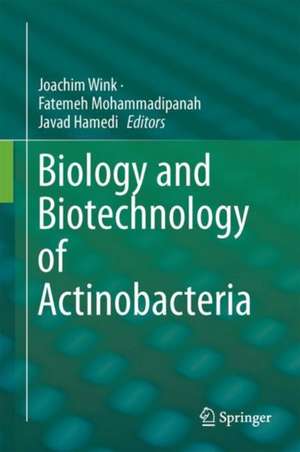Biology and Biotechnology of Actinobacteria
Editat de Joachim Wink, Fatemeh Mohammadipanah, Javad Hamedien Limba Engleză Hardback – 3 noi 2017
| Toate formatele și edițiile | Preț | Express |
|---|---|---|
| Paperback (1) | 792.83 lei 39-44 zile | |
| Springer International Publishing – 23 aug 2018 | 792.83 lei 39-44 zile | |
| Hardback (1) | 941.77 lei 3-5 săpt. | |
| Springer International Publishing – 3 noi 2017 | 941.77 lei 3-5 săpt. |
Preț: 941.77 lei
Preț vechi: 1148.50 lei
-18% Nou
Puncte Express: 1413
Preț estimativ în valută:
180.29€ • 185.42$ • 149.57£
180.29€ • 185.42$ • 149.57£
Carte disponibilă
Livrare economică 30 ianuarie-13 februarie
Preluare comenzi: 021 569.72.76
Specificații
ISBN-13: 9783319603384
ISBN-10: 3319603388
Pagini: 430
Ilustrații: VII, 395 p. 80 illus., 41 illus. in color.
Dimensiuni: 155 x 235 mm
Greutate: 0.8 kg
Ediția:1st ed. 2017
Editura: Springer International Publishing
Colecția Springer
Locul publicării:Cham, Switzerland
ISBN-10: 3319603388
Pagini: 430
Ilustrații: VII, 395 p. 80 illus., 41 illus. in color.
Dimensiuni: 155 x 235 mm
Greutate: 0.8 kg
Ediția:1st ed. 2017
Editura: Springer International Publishing
Colecția Springer
Locul publicării:Cham, Switzerland
Cuprins
Introduction.- Cellular structure of actinobacteria.- Growth and life Cycle of actinobacteria.- Classification and taxonomy of actinobacteria.- Genetic of actinobacteria.- Ecology and habitat distribution of actinobacteria.- Physiology of actinobacteria.- Regulation of secondary metabolites of actinobacteria.- Symbiosis and pathogenisity of actinobacteria.- The role of actinobacteria in biotechnology.- Practical aspects of working with Actinobacteria.- Post genomic studies and systems biology of actinobacteria: a brief overview.
Notă biografică
Joachim Wink has received his PhD from Frankfurt University, Germany in 1985. He then went into the pharmaceutical industry and started his career at the Hoechst AG, where he was responsible for the strain collection and specialized in the cultivation and taxonomic characterization of Actinobacteria and Myxobacteria. Over the years he became responsible for the strain library within the pharmaceutical research and a number of screening projects with Hoechst Marion Russel, Aventis and Sanofi. In 2005 he completed his postdoctoral degree at the Carolo Wilhelma University of Braunschweig, and in 2012 he transferred to the Helmholtz Centre for Infection Research in Braunschweig, where he founded the strain-collection working group and is currently working on the isolation and taxonomic characterization of Myxobacteria and Actinobacteria, as well as the analysis of their secondary metabolites. He has published more than 50 papers on secondary metabolites and the taxonomy of the producing microorganisms in reputed journals, a number of reviews and book chapters, and holds more than 35 patents. He is a member of the editorial board of several international journals.
Fatemeh Mohammadipanah completed her PhD project in a joint program between the University of Tehran and University of Göttingen in 2011. She has been working on Actinobacteria since 2008, when she started the taxonomical study of Actinobacteria at the DSMZ. She has been an Assistant Professor at the University of Tehran since 2012. Her primary research interests are in the isolation, taxonomy and in particular bioactive secondary metabolites of bacteria.
Javad Hamedi, College of Science, University of Tehran, Tehran, Iran.
Javad Hamedi, College of Science, University of Tehran, Tehran, Iran.
Textul de pe ultima copertă
This book provides in-depth insights into the biology, taxonomy, genetics, physiology and biotechnological applications of Actinobacteria. It especially focuses on the latter, reviewing the wide variety of actinobacterial bioactive molecules and their benefits for diverse industrial applications such as agriculture, aquaculture, biofuel production and food technology. Actinobacteria are one of the most promising sources of small bioactive molecules and it is estimated that only a small percentage of actinobacterial bioactive chemicals have been discovered to date. Identifying new diverse gene clusters of biotechnological relevance in the genome of Actinobacteria will be crucial to developing advanced applications for pharmaceutical, industrial and agricultural purposes. The book offers a unique resource for all graduate students, researchers and practitioners in the fields of microbiology, microbial biotechnology, and the genetic engineering of Actinobacteria.
Caracteristici
Highlights numerous applications of bioactive molecules from Actinobacteria Provides a comprehensive overview on biology, taxonomy and genetics of Actinobacteria Discusses state of the art methods for the work with Actinobacteria
